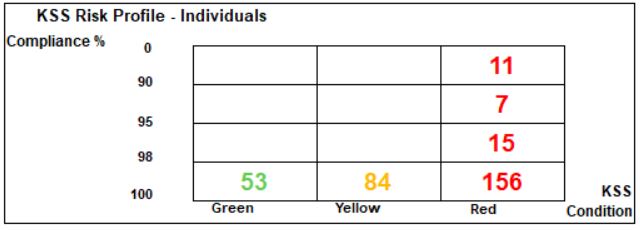InterDynamics » Fatigue Risk Management Solutions » Fatigue Risk Management Services » Hours of Work Diagnostics
Hours of Work Diagnostics
An Hours of Work Diagnostic examines your planned future roster or historical activity utilising FAID Quantum. These results can then be reported to you in varying levels of detail which can assist in your decision-making and analysis of exposure.
Our initial review includes an indication of the overall fatigue exposure of the Hours of Work analysed, as well as from an Hours of Work perspective, those that are potentially at higher risk. This is provided in a spreadsheet format of FAID Quantum outputs as well as a discussion on the outputs with you and your team.
If a more comprehensive review or analysis is required, then our Diagnostic Reports can provide detailed commentary on various roster patterns or twelve months or more of Hours of Work data for your organisation, indicating the overall organisational fatigue exposure associated with Hours of Work.
Within the report, a ranking of individuals with highest Hours of Work fatigue exposures is also provided and discussed.

KSS Risk Profile showing 11 individuals with less than 90% compliance against a KSS Tolerance Level of 7 (Total Hours worked over 12 months (for 326 individuals) 466,294 hours.

Using the same dataset, the FAID Score Risk Profile shows15 individuals with less than 95% compliance against a FAID Score Tolerance Level of 80.
An Hours of Work Diagnostic Report can be used to:
- Understand an organisation’s current Hours of Work fatigue risk profile from an analysis and review of the most recent 12 months (or more) historical Hours of Work data for all or specific personnel. Comment can be provided on current (apparent) organisational Fatigue Tolerance Levels, and current relative Fatigue Tolerance Levels and hours of work exposuresby role / crew / base type groupings (if provided)
- Review changes in Hours of Work fatigue exposure trends over time
- Plan rosters within agreed fatigue exposure levels
- Audit actual hours of work to ensure compliance within agreed fatigue exposure levels, and consider business process improvements for non-compliant hours
- Identify highest hours of work fatigue exposure work patterns / rosters, and consequently higher hours of work fatigue exposure teams / bases, or by role / job type
When are our Hours of Work Diagnostic services utilised?
Organisations typically utilise our Hours of Work Diagnostic services to harness the power of FAID Quantum in understanding the relative fatigue exposures of their planned or actual Hours of Work when:
- FAID Quantum is not being used internally to plan or audit Hours of Work
- Written reports or FAID Quantum outputs are required on Hours of Work risk profiles
- Changes to rosters are being considered
- Analysis is required on the relative fatigue exposures of various roster patterns
- Actual Hours of Work are being audited against planned Hours of Work and/or organisational Fatigue Tolerance Levels (suggested at least annually)
- The fatigue exposure of Hours of Work surrounding a workplace incident or accident is under investigation
- In Step One of our Risk-Based Approach to fatigue management (Determining the fatigue risk profile of the organisation)

KSS Score Plot showing shifts worked above the KSS Score Tolerance Level (red lines)

FAID Score Plot showing shifts worked above the FAID Score Tolerance Level (red bars)
What is required?
All that is required is the start and finish date and time of each work period for each person or work pattern under analysis.
View an example of the FAID Quantum data format required. Alternately, we can assist you in the translation of your data into the FAID format for analysis.
The importance of a biomathematically modelled roster.
Compliance to prescriptive hours of work rules may not be sufficient to ensure safety with regards to fatigue.
Many regulators and industry bodies recognise that within a Fatigue Risk Management System, adequate management of fatigue-related risks associated with working hours includes more than working hour limits. Circadian influencers and biological limits to recovery are also important. Consideration of these factors can most effectively and efficiently be supported by the strategic use of a bio-mathematical model such as FAID Quantum.
In taking into account the time of day and duration of work / break periods, the accumulating effect of fatigue, and the biological limits on recovery sleep, FAID Quantum provides greater rigour to the risk management process of managing Hours of Work. Apart from using FAID Quantum, it is difficult to include these factors in hours of work rules without these rules being very complex and prescriptive, thereby restricting viable business operations.
Often, a FAID Quantum Hours of Work Diagnostic report will complement one or more of the Educational or Risk Assessment Workshops InterDynamics provides as part of our Risk-Based Approach.
For more information about FAID Quantum Hours of Work Diagnostic or our Educational / Risk Assessment Workshops
Our Services
Resources and Media
Visit our media library for a comprehensive collection of articles, downloads and presentations related to fatigue risk management.
